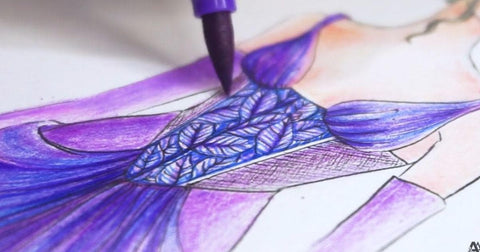Watercolor vs. Acrylic: A Quick Guide
Last Updated: November 5, 2024
Color is one of the biggest elements of any artwork. In some ways, color can speak a language of its own and depict things like emotions and messages, which is why artists should choose the right color options suited to their desired creative output.

There are different types of coloring materials to choose from as well. In this guide, we’ll be going over two popular color options – watercolors and acrylics. We’re going to help you learn some of their key differences and characteristics to choose the right one for your project!
Watercolor VS Acrylic: Which One Should You Choose?
The important thing to remember when choosing the right coloring materials is the look, vibe, and overall result you’re looking for. In the coming sections, we’ll help you choose whether things like acrylic markers or watercolors are better suited to your projects:
Getting to Know Watercolors
The use of watercolors dates back to the Paleolithic Era in Europe, where traces of this coloring method were found in caves. Since then, it has evolved and was widely used for art during the Renaissance Era. Today, watercolors are primarily used for painting and other artistic projects, so the watercolors you’re using owe their existence to thousands of years of history and evolution!
As the name suggests, watercolors are primarily made up of water and any type of pigment. When applied on paper or canvas, it results in a somewhat textured and layered effect, perfect for painting things like scenery. Famous artists like Van Gogh and O’Keeffe have been known to prefer watercolors when creating their masterpieces.
Are you thinking about making watercolor art or maybe paintings to display at home? Take a look at the coming sections to learn if this material is for you!

Advantages
#1 - Easy to Work With
Watercolors have low toxicity and are water-soluble as well (hence its name!) so this material is known to be easy and convenient to work with. You can typically choose from different watercolor types such as pans, tubes, and liquid, all of which are incredibly versatile and easy to use when painting or working on other artprojects.
#2 - A Variety of Techniques
Another advantage you can expect with using watercolors is that there are different methods to explore. Some watercolor techniques you must try include wet-on-wet to create a textured effect, applying watercolors with a dry brush for more vibrant hues, or layering colors to achieve a mixed or blended effect. You can play around with these to achieve your desired result!
#3 - Quick-drying
Last but not least, watercolor paint is known to be low maintenance and quick-drying. It depends on the mixture of paint and water that you place on your canvas, but it typically only takes a few minutes for your artwork to dry. Just make sure that while you’re letting your painting dry, there are no items near or on top of it smudging the paint.

Limitations
#1 - Absorption Properties
Watercolor paint has a reputation for bleeding through paper fibers. Since it’s partially made with water, it will act as such and go right through most materials. However, using canvas or specialty papers suited for watercolors will minimize bleeding and produce neat, better-looking artwork.
#2 - Takes Practice to Master
Much like other art materials or techniques, using watercolor paint for the first time means familiarizing yourself with it first. It takes some time and practice to get confident with using it, so take your time! Feel free to research things like which watercolor pan set is best for you or techniques to try as a beginner.
Getting to Know Acrylics
Acrylic paint isn’t nearly as old as watercolors. They have been around since 1934 and began being widely used by artists by 1960 for a variety of masterpieces. Some of the most popular artists who used acrylics in their art include Robert Motherwell, Kenneth Noland, and Helen Frankenthaler.
Nowadays, acrylic paint is still being used, but people also like the idea of using acrylic markers, which are essentially the same thing but in a more neat and controlled medium. Simply put, you can experience the combined beauty of paint and writing materials! If you’re considering using acrylic markers for your own artwork, check out the coming sections to learn more:

Advantages
#1 - Quick-Drying
Similar to watercolors, acrylics are very quick to dry. Once you’re done with your artwork, all you have to do is let it sit for a few minutes, and you’re all good to go! This will make your creative process quicker and more efficient moving forward.
#2 - Clean, Opaque Finish
Next up, acrylics are also known for having a more smooth finish. If watercolors have a light, almost translucent effect, then acrylics are more solid and opaque. This is perfect if you want to make a statement with your artwork or need to utilize visible colors.
#3 - Vibrant Color
Aside from its opaque properties, acrylics usually have brighter, more vibrant colors as well. It’s perfect for fine and intricate art because you can see the details more closely, especially if you play around with different color families.

Limitations
#1 - Refills
Over time, your acrylic markers will need to be refilled or replaced. This is a relatively easy process because, much like other art products, you’ll have to refill or get new ones when you run out.
#2 - Blending
Blending with acrylic markers isn’t impossible, but it’s not exactly easy either. Since it has solid, opaque properties combined with the quick-drying feature, blending colors may prove to be a challenge. If you’re looking to make layered, ombre effects with your artwork, then maybe watercolors would be better!
Make Your Art Projects Stand Out with Vibrant Colors!
We hope this guide has helped you decide between watercolors and acrylics. If you’re still torn, consider experimenting with both of them down the line and see which one works better for your personal preference and art style. Both have advantages and limitations, but you can certainly make stunning artwork with either one!
Learn more about all things watercolors and acrylics in The Creative Corner!










Hi Tricia! Thank you! Glad you found these blogs interesting. :)
Really interesting feature, especially the Caravaggio article.